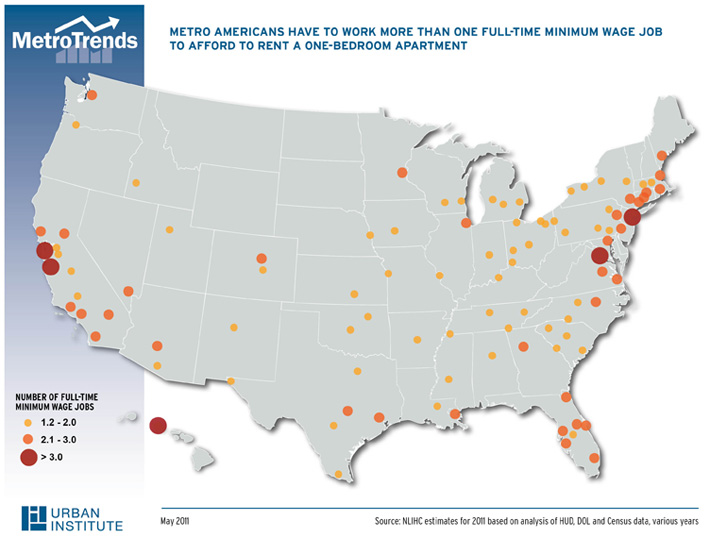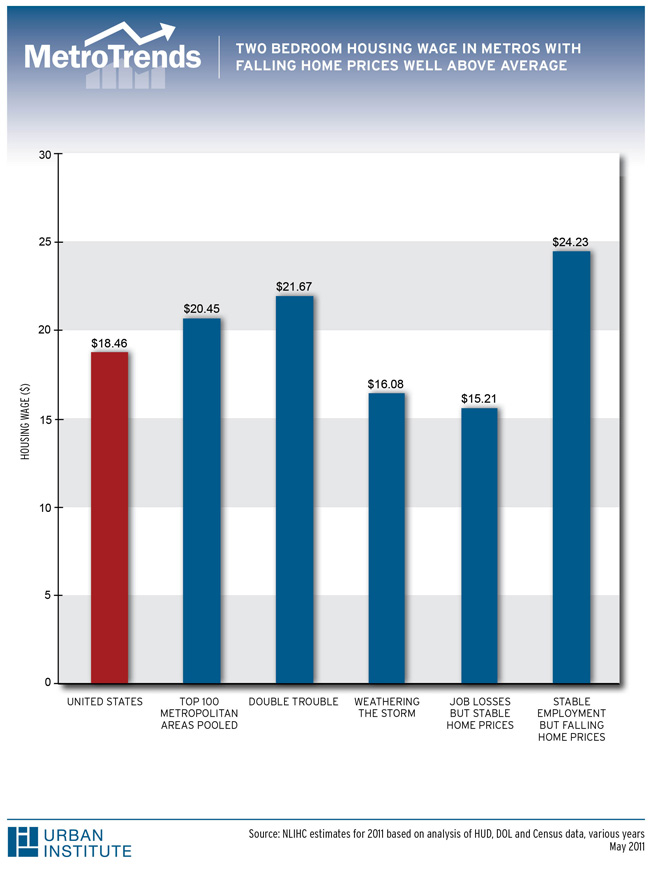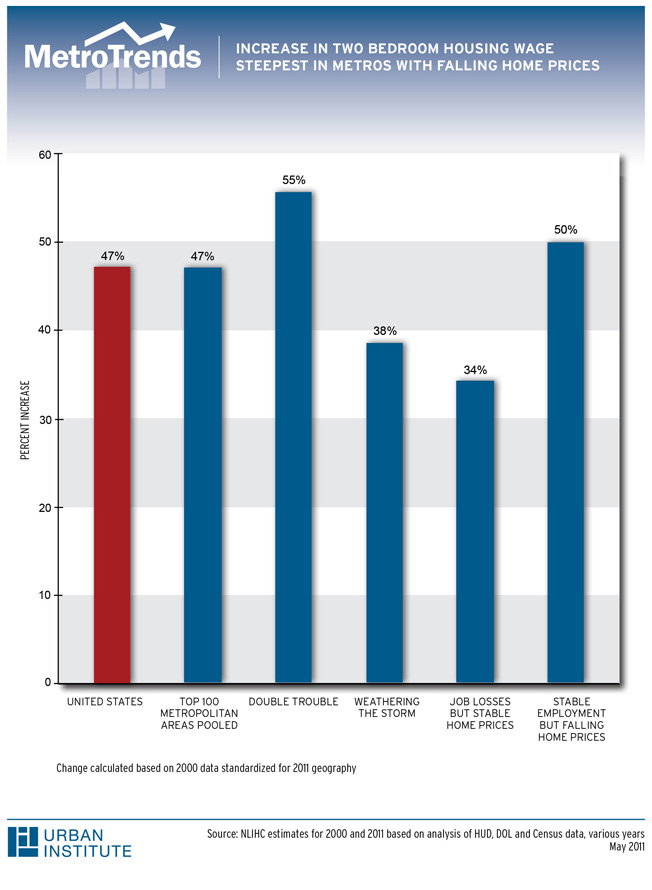
|
|
The 2011 Housing Wage Can the Recession Bring an Age of Improving Expectations for Affordable Housing?When we released our "Out of Reach Report" this year, we led the press release, as we have for the majority of the last 22 years, with the Housing Wage, the statistic that on average in 2011 a household needs to earn $18.46 an hour, working 40 hours a week, 52 weeks a year, to afford a two-bedroom home at the Fair Market Rent. This year we also noted that while this is just two cents higher than last year, our estimated average renter wage declined by nearly a dollar from $14.44 to $13.52 and there was no increase in the minimum wage. Hence, despite the recession and flat rents in much of the country, once again the affordability of housing for America's low income households deteriorated significantly. In recent years, presenting these numbers almost immediately leads a skeptical reporter to question our finding that housing is unaffordable, not because the rent levels or the wages we report are out of whack, but because we are making the assumption that there is only one wage to support a two-bedroom apartment. Wouldn't there likely be two wages to pay for such a big apartment, the reporter will ask, and with two wages wouldn't it be affordable? Expecting this, we go on to note that relatively large numbers of single-parent households make up the low wage workforce as well as the elderly and disabled who may need a larger apartment. But to nail the case shut we point out that the national Housing Wage for a 1-bedroom apartment is $15.48, still well out of reach for the average renter. In our nation's largest cities, a one-bedroom apartment at the Fair Market Rent can be several multiples of the minimum wage. Workers in San Francisco have to work nearly 4. This reasoning generally convinces all but the most closed-minded critic that we are not trying to pull a fast one, and that housing really is out of reach. So why do we continue to lead our report with the two-bedroom Housing Wage? We do it on principle. When NLIHC first began to use the Housing Wage, there remained an expectation in this country that a two-bedroom rental home was modest and should be affordable to families with one wage earner, even if there were two adults in the home. The increasing frequency with which this basic comparison in our report between a single wage and a two-bedroom apartment is questioned seems a clear indication of how diminished our expectations have become in the last decade. Like the proverbial lobster pot, the heat in our housing markets has slowly been turned up on us and we don't realize how much hot water we are in. Among the top 100 metro areas the average two-bedroom housing wage is now $20.43. As might be expected, areas that experienced the boom in housing prices and that have maintained robust job markets in the recession continue to have the highest rent levels. But it is the "Double Trouble" areas that show how dysfunctional our housing markets have become. These areas experienced the fastest growth in the cost of a modest rental home from 2000 to 2011. While rents grew with the housing bubble and boom in these areas, they have also remained strong with the bust. Despite falling home prices and declining employment in these areas for the past few years, the Housing Wage remains well above the average for all of the largest 100 metro areas and the nation as a whole. And it continues to take more than 2 jobs at the minimum wage on average to be able to afford even a one-bedroom rental home at the Fair Market Rent in these areas. That rents are holding strong in the recession, even in the worst hit Double Trouble metro areas, is largely because with foreclosures and diminished incomes, credit and expectations has come a dramatic increase in the demand for renting nationwide. According to the Current Population Survey, nationwide, the proportion of renters in this country fell consistently throughout the 1990s and early 2000s, hovering as low as 31% from 2004 to 2006. But within the last four years the renter rate has already jumped back up to its 1998 level of nearly 34% and it looks set to continue to rise. This translates into nearly 4 million more rental households nationwide. For comparison, during the entire 1990s the nation gained just under 1 million renter households. This growing demand for rental housing comes against the backdrop of declining support for affordable housing and a persistent, strong anti-renter bias in many if not most American neighborhoods. The result will be rising rents and declining affordability for years to come... unless we work hard to accommodate these new renters through a net increase in housing assistance and changed local attitudes to encourage responsibly managed affordable rentals. The recession has caused greater housing hardship, but it is also important to remember that the failure of this country's housing system to produce sufficient affordable housing is itself at the root of the crisis. Therefore, the increase of incomes relative to housing prices will be an important indicator of how sustainable the economic recovery is likely to be and whether we are recovering our appropriate expectations of what can be required of a household simply to afford a modest home. The two-bedroom Housing Wage will be an indicator of our progress, as it has been for over 20 years. |
Experts Feedback
Send us your comments to help further the discussion. Share
Commentaries
|







